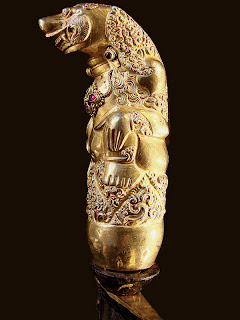



Description : Kris Gold, Wood, Gold inlayed Iron, Ruby Precious Gemstones, Iron
Origin : Banjarmasin, Kalimantan (Borneo)
Age : 17th Cent. A.D.
Dimensions :
- Length: 46 cm
- Width: 15 cm
- Depth: 3 cm
- Blade: 28 cm
- with Handle: 36 cm
Weight : 300 grams
Price : US$46,000
This early (circa 17th century) kris is from Banjarmasin an important Malay trading port located on the southern coast of Borneo. Like many of the major trading centers of Borneo, Banjarmasin was ruled by a Malay court that was strongly influenced by Java, which maintained many Hindu-Buddhist conventions even after most the inhabitants of the island were nominally converted to Islam. This is seen directly in the gold handle of this kris. Solid gold it depicts a long nosed raksasa or demon with bulging eyes and long curly locks that is based on the dvarapala guardian demon statues that flank the entrances to Hindu and Buddhist temples. Notably the handle is cast like the gold knife and kris handles dating from the late Javanese Majapahit Empire (13 to 15th centuries) upon which so many succeeding courts, including those who had converted at least nominally to Islam, were based. Casting using the lost wax method is not only an indicator or great age but also stands in contrast to the larger but similar Balinese gold handles. Although the latter are a continuation of the same tradition, Balinese handles are not cast but rather made by the combination of repoussé and carving. The raksasa in the handle is rather elongated and its necklace encrusted with high quality hand polished Burmese rubies.
Another unique characteristic of this magnificent kris is that both the black iron upper half of the sheath cover and the kris ring below the handle are inlaid with a pure gold floral motif, a technique that has long since disappeared. The kris’s wrangka is of burl wood and the lower half of the sheath covered in gold in a style that resembles the krisses of the Malay kingdoms of Sumatra and the Buginese and Makasaarese kingdoms of southern Sulawesi. Interestingly the handle of this kris also resembles handles of the archaic krisses of that region (see 00003) in that they are figurative and also cast using the lost wax method.
The blade of the kris has a fine damascene pattern or pamor. It has 9 curves or luk.









































